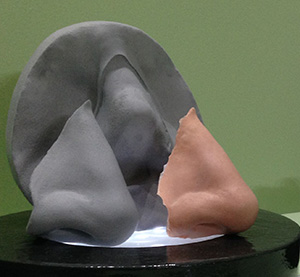Prototypes and parts, objects of all kinds, clothing, architecture and cars: 3D printing is everywhere but, undeniably, its most fascinating and revolutionary potential is found within the possibilities it offers the healthcare sector. 3D printed organs may still be a few years away but the field of prosthetics is easily within reach. Being able to 3D print a prosthesis, perfectly fit for the specific need of each patient perhaps, means that anyone can have a new, functional hand, arm, leg or foot in a matter of days at extremely reduced costs. This video by Fripp Design & Research shows that it is now possible to 3D print soft tissue prostheses as well: noses, ears, and lips made to measure and almost indistinguishable from their “real” counterparts or from the patient’s skin colour.
Based in the Advanced Manufacturing Park Technology Centre in Sheffield, UK, Fripp Design & Research offers services ranging from product to industrial and concept design, as well as product development and research. The project described in the video is part of a cooperative effort with the University of Sheffield that aimed to demonstrate the feasibility of soft tissue prostheses manufacturing and process automation for repeat orders through the use of 3D printing technologies. The project was awarded a £500,000 grant by the Wellcome Trust, a well know global charitable foundation dedicated to improving human and animal health, to develop a commercially viable solution for the British NHS.
As Professor Ric Van Noort, of the University of Sheffield, put it: “the current process of making and fitting prostheses is archaic at best. It requires taking an impression from the patient, making the mould, hand painting it and then modifying it to fit. It is time-consuming, highly variable and expensive”. There had to be another way and Fripp D&R set out to find it. The system they developed captures 2D colour and 3D spatial data independently but that will change as the cost of 3D scanners continues to decrease and the quality increases, allowing for one time 3D captures of colours and forms. The model is then printed using a breakthrough powder based system and 100% biocompatible materials. The benefits of such a process cover just about everything: they require no invasive impressions, turnaround times are dramatically reduced, textures are consistent and replacements can be provided at the press of a button. For healthcare providers this means reduced costs and wider accessibility to patients with limited financial means. The healthcare revolution, apparently, is already, quite literally, under our noses.



